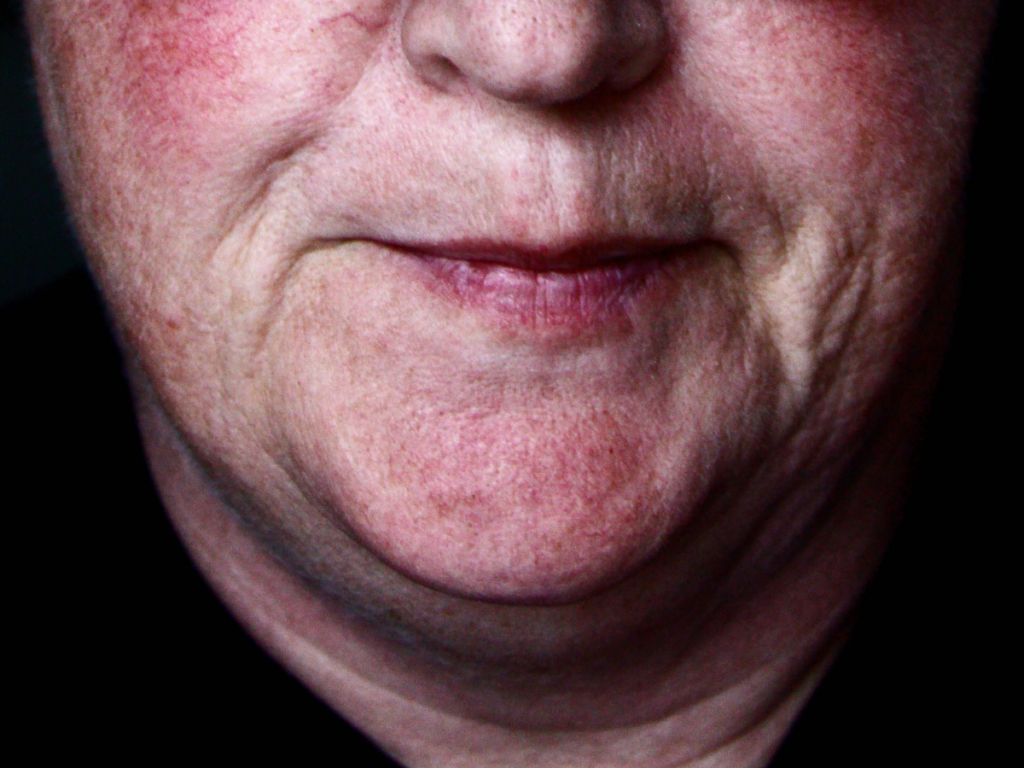You might just have received a diagnosis. Or perhaps you suspect you might have rosacea and want to investigate further. Whatever your reason to understand this skin condition, we can help. Read on to learn what rosacea is, what causes it and the best ways to treat it.
What is rosacea?
Rosacea is a relatively common chronic inflammatory skin condition. You may notice symptoms like facial flushing, small visible blood vessels, small spots and bumps or watery or irritated eyes when you have it (1). Although it can appear at any time, flare-ups often start between the age of 30–60 years, then typically will relapse and remit after that (2). It mostly affects the cheeks, chin, nose, and central part of forehead, and can also cause the skin to feel hot and uncomfortable (3).
What causes rosacea?
Current research indicates rosacea may be caused by microscopic Demodex mites, which are tiny organisms that live in oil glands and hair follicles on your face. It’s natural for them to live on your skin, but they can cause inflammation in some people. This inflammation affects the skin’s blood vessels and nerves, leading to rosacea symptoms.
Other risk factors for developing rosacea include:
- Genetic susceptibility
- Increasing age
- Fitzpatrick skin types 1-2 / Northern European ancestry
- Sunlight exposure
- Triggers like smoking, alcohol, spicy foods and hot drinks
- Hot or cold temperatures
- Emotional stress and exercise
How do I know I’ve got rosacea?
This is a really common question because by its very nature, rosacea can be confused with a number of other skin conditions, particularly ones associated with inflammation. Here’s how to tell the difference.
Acne: Rosacea bumps resemble acne pimples but are typically smaller with no blackheads. Acne also commonly occurs at a younger age.
Dermatitis: Rosacea flushing can be mistaken for facial allergies, but it’s not associated with itching or hives (5).
Lupus: Lupus erythematosus is sometimes mistaken for rosacea because of the butterfly-shaped rash it can cause on the cheeks and nose.
Psoriasis: When facial psoriasis flares up, it can look similar to rosacea, but will often also trigger raised patches of skin, known as plaques. It’s important to identify the condition you’re experiencing before starting treatment, as psoriasis can be helped by topical steroids and sun exposure, which can both contribute to further rosacea flare-ups (5).
A doctor, dermatologist or online dermatology service can help diagnose your specific symptoms using careful evaluation of the behaviour, location and timing of the signs and symptoms. To learn more, start a rosacea consultation online today.
How common is it?
Rosacea is common, affecting 5.46% of the world’s population. It occurs frequently between the ages of 20–30 and then 40–50, and is more common in women and people with fair skin (6) and those with celtic or scandinavian ancestry (7).
What’s the best way to manage my rosacea?
The most effective thing you can do to manage flare-ups of rosacea is to identify your triggers, then work out a plan to avoid or reduce exposure to them. A recent survey from the National Rosacea Society found that over 81% of rosacea patients cited sun exposure as a trigger factor for flare ups. Other factors included extreme temperatures (hot or cold baths, swimming, air-conditioning, heating) and stress. Because of this, you may find that taking short, lukewarm showers and practicing relaxation techniques like yoga or meditation can help.
Skincare is another important part in soothing your symptoms. Depending on the severity of your rosacea, you might find an azelaic acid gel or cream to be effective at reducing inflammation and pimples. A recent study by Dermatica has shown good evidence that azelaic acid, especially 15-20%, is an effective and well-tolerated treatment for rosacea. Ivermectin cream might be recommended as an antiparasitic to kill mites and lessen lesions, and a brimonidine gel can be used to treat episodic flushing (8).
As UV exposure is also a common culprit in triggering rosacea, it’s important to protect your skin with a sunscreen SPF30 +. We also recommend avoiding harsh, abrasive scrubs and choosing gentle cleansers, or washing with an emollient formulated specifically for sensitive or easily-irritated skin.
Facing winter with rosacea
Exposure to extreme temperatures can have a big impact on rosacea. This is particularly the case in winter as cold weather can worsen rosacea by increasing inflammation, damaging the skin barrier, stimulating sensory nerves, and causing blood vessel changes that lead to flushing and redness. But luckily, there are some ways to help protect your skin when the temperature drops.
- Protect your skin daily by wearing rosacea-friendly sunscreen and a soothing moisturiser (emollient).
- Limit your time outdoors if this is a significant trigger
- If you’re using a rosacea treatment plan, avoid taking a break from your formula, particularly during cold spells (9).
Looking to soothe a rosacea flare-up? Start your free online consultation today.
References
- National Rosacea Society https://www.rosacea.org/
- DermNet https://dermnetnz.org/topics/rosacea
- National Institute for Health and Care Excellence https://cks.nice.org.uk/topics/rosacea/
- American Academy of Dermatology Association https://www.aad.org/public/diseases/rosacea/what-is/causes#:~:text=By%20studying%20rosacea%2C%20scientists%20have,people%20inherit%20genes%20for%20rosacea.
- National Rosacea Society https://www.rosacea.org/blog/2016/june/red-skin-rashes-are-not-always-the-result-of-rosacea
- National Institute for Health and Care Excellence https://cks.nice.org.uk/topics/rosacea/background-information/prevalence/
- American Academy of Dermatology Association https://www.aad.org/public/diseases/rosacea/what-is/causes#:~:text=By%20studying%20rosacea%2C%20scientists%20have,people%20inherit%20genes%20for%20rosacea
- National Institute for Health and Care Excellence https://cks.nice.org.uk/topics/rosacea/management/rosacea/
- American Academy of Dermatology Association https://www.aad.org/public/diseases/rosacea/triggers/prevent#:~:text=Protect%20your%20face%20from%20wind%20and%20cold&text=A%20windburn%20can%20trigger%20a,your%20eyes)%20with%20a%20scarf.

